Abstract
The etiologic agent for the acquired immunodeficiency syndrome (AIDS) is now firmly established as the retrovirus termed the human T-lymphotropic virus type III (HTLV-III) or the lymphadenopathy-associated virus, LAV. The disease is characterized by profound and progressive loss of immunity, but molecular evidence indicates that only a few cells in peripheral blood are being productively infected with this virus. In the present study we have investigated a disrupted HTLV-III viral preparation for biologic effects on normal lymphoid cells. Relatively dilute concentrations of this preparation were found to stimulate immunoglobulin secretion by peripheral blood lymphocytes; at the same dosages, the preparation was inhibitory for the B-cell differentiation responses that are induced with other known polyclonal B-cell activators, pokeweed mitogen, Staphylococcus aureus, and Epstein-Barr virus. This preparation was also inhibitory at high concentrations for T-lymphocyte proliferative responses to phytomitogens and antigens and resulted in a reduced expression of Tac antigen on phytohemagglutinin-activated lymphocytes. Paradoxically, incubation of lymphocytes of certain healthy donors with the HTLV-III preparation alone resulted in increased expression of Tac and Leu-12 antigens. These findings show that a disrupted preparation of HTLV-III virus can mimic many of the immunologic abnormalities present in patients with HTLV-III infection. Nonviable viral proteins may be responsible for some of the immunologic perturbations that occur in HTLV-III-infected states.
Full text
PDF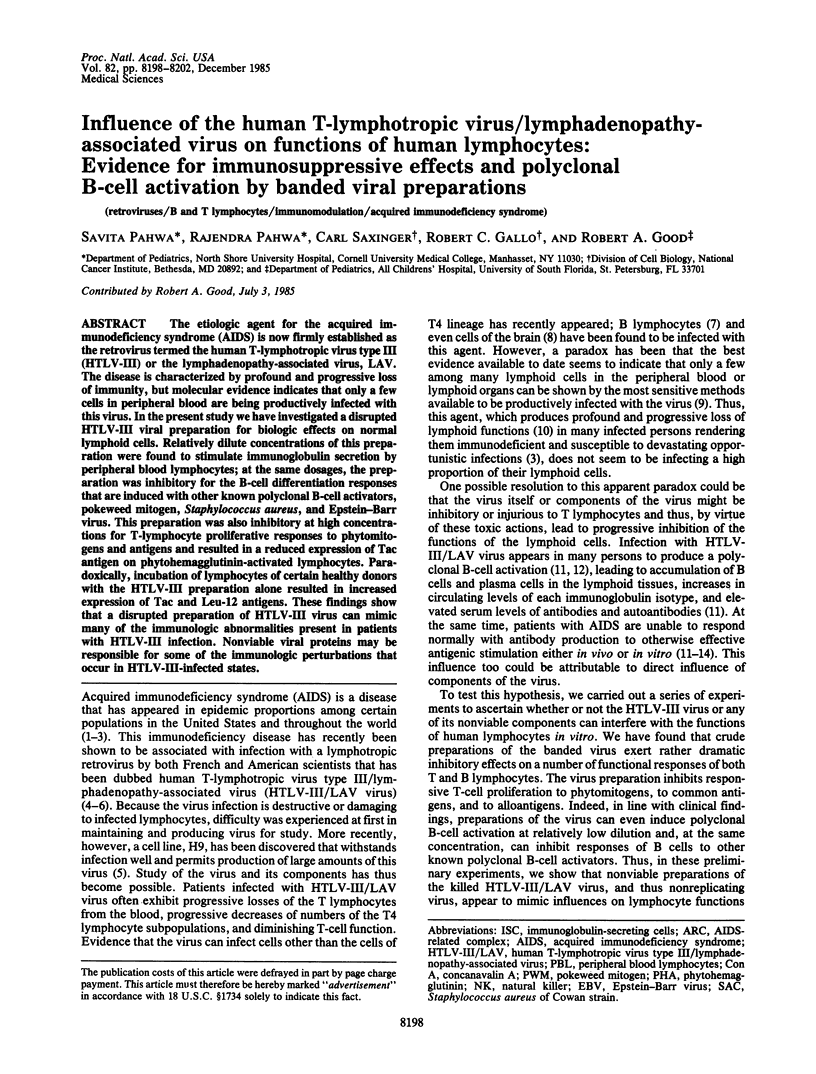
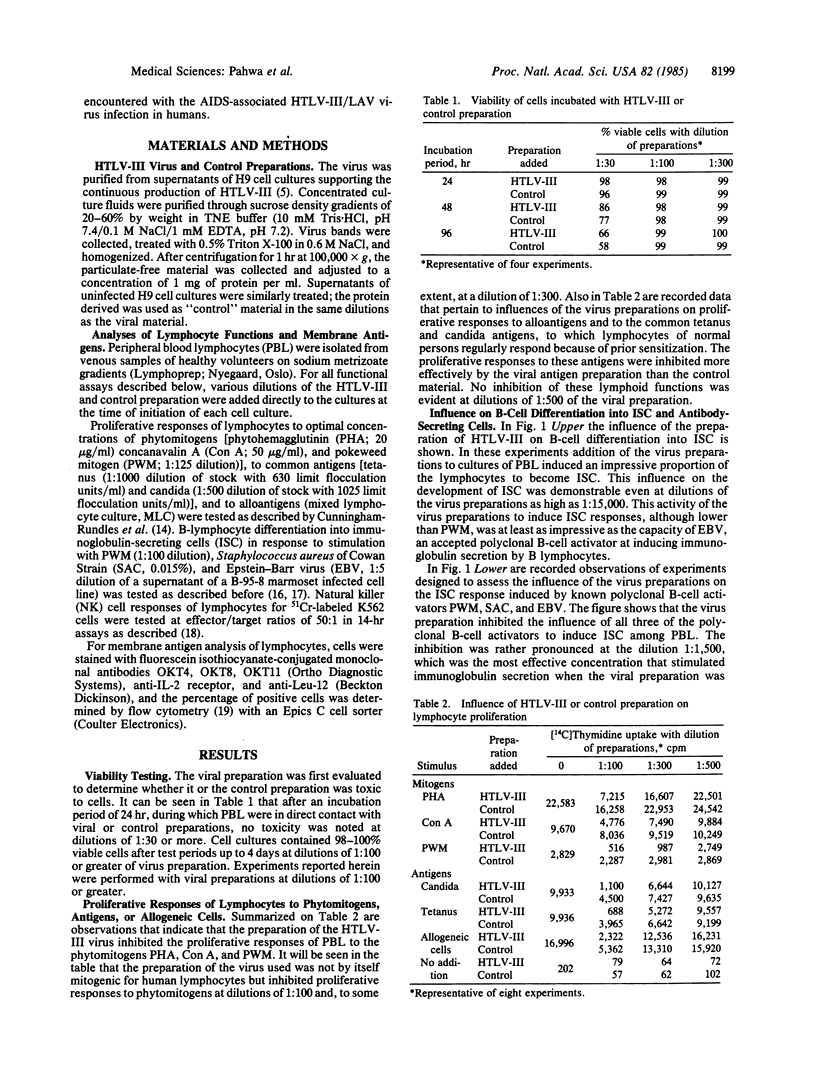
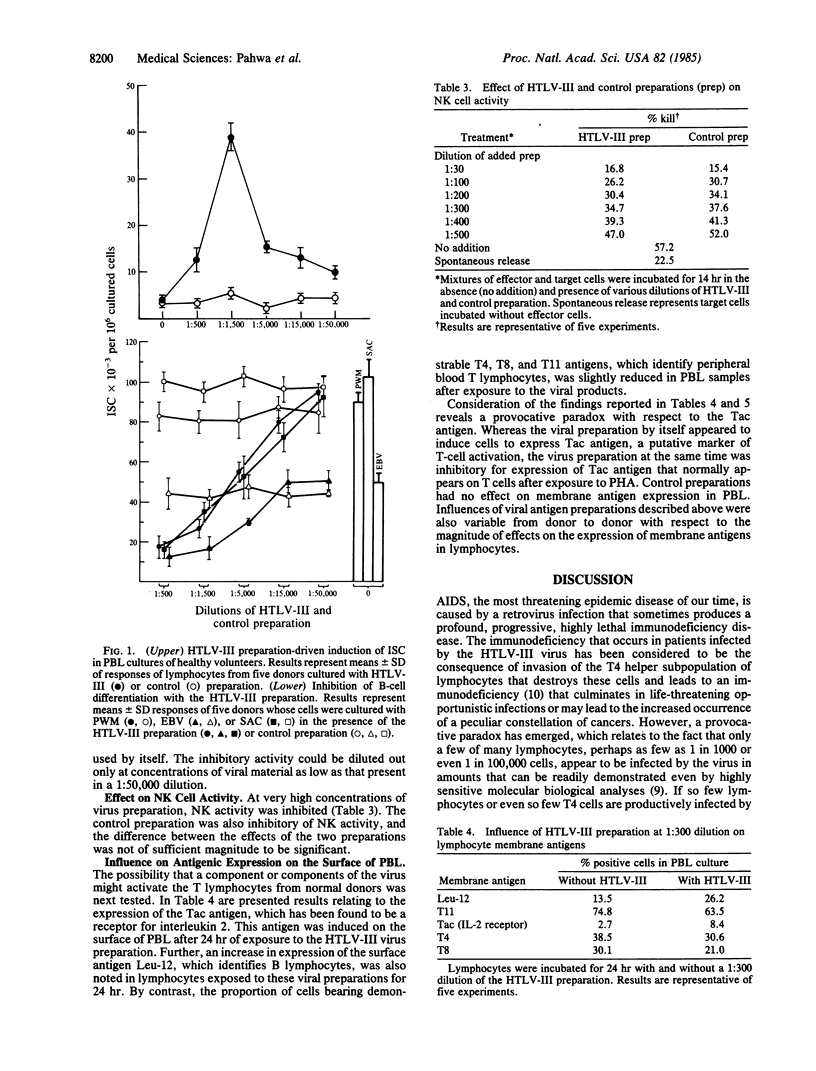
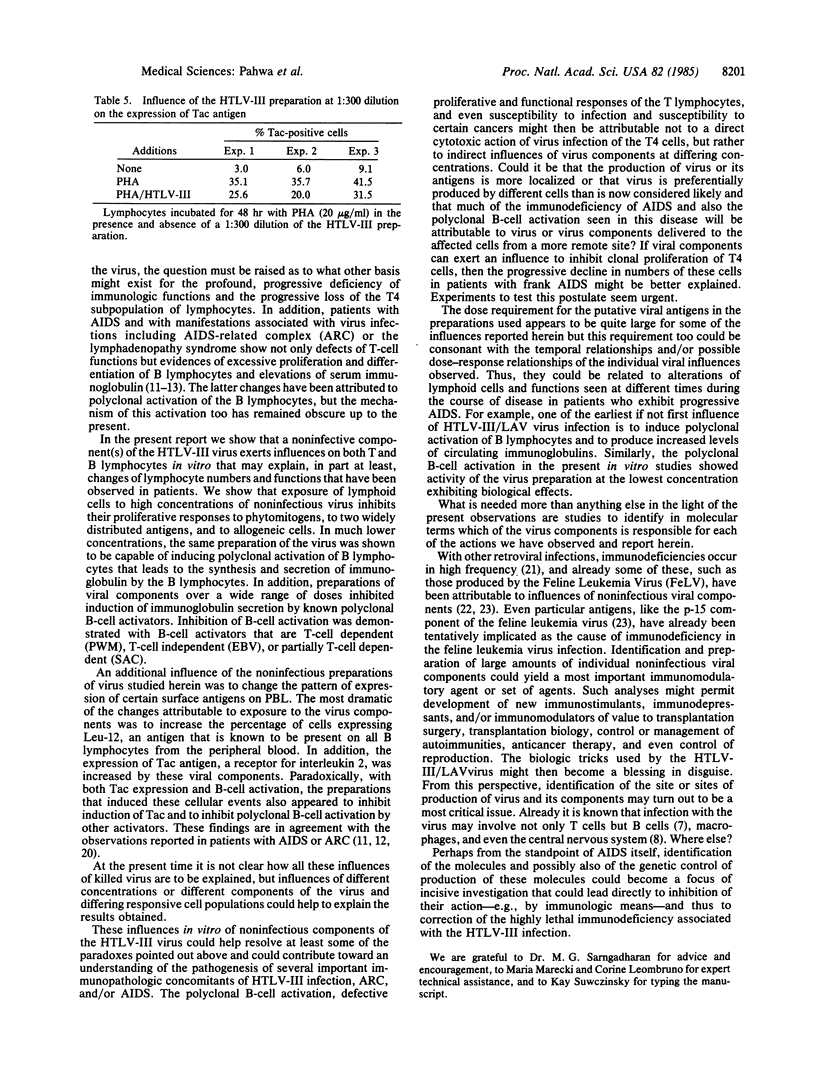
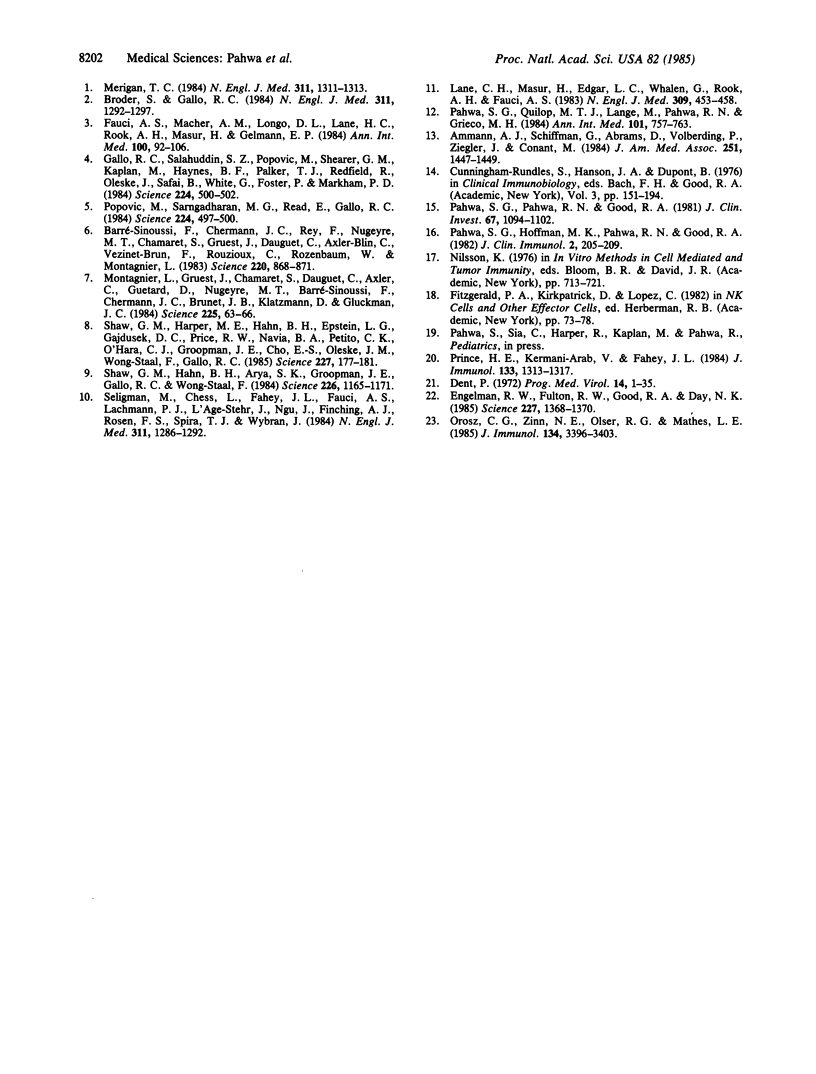
Selected References
These references are in PubMed. This may not be the complete list of references from this article.
- Ammann A. J., Schiffman G., Abrams D., Volberding P., Ziegler J., Conant M. B-cell immunodeficiency in acquired immune deficiency syndrome. JAMA. 1984 Mar 16;251(11):1447–1449. [PubMed] [Google Scholar]
- Barré-Sinoussi F., Chermann J. C., Rey F., Nugeyre M. T., Chamaret S., Gruest J., Dauguet C., Axler-Blin C., Vézinet-Brun F., Rouzioux C. Isolation of a T-lymphotropic retrovirus from a patient at risk for acquired immune deficiency syndrome (AIDS). Science. 1983 May 20;220(4599):868–871. doi: 10.1126/science.6189183. [DOI] [PubMed] [Google Scholar]
- Broder S., Gallo R. C. A pathogenic retrovirus (HTLV-III) linked to AIDS. N Engl J Med. 1984 Nov 15;311(20):1292–1297. doi: 10.1056/NEJM198411153112006. [DOI] [PubMed] [Google Scholar]
- Dent P. B. Immunodepression by oncogenic viruses. Prog Med Virol. 1972;14:1–35. [PubMed] [Google Scholar]
- Engelman R. W., Fulton R. W., Good R. A., Day N. K. Suppression of gamma interferon production by inactivated feline leukemia virus. Science. 1985 Mar 15;227(4692):1368–1370. doi: 10.1126/science.2983424. [DOI] [PubMed] [Google Scholar]
- Fauci A. S., Macher A. M., Longo D. L., Lane H. C., Rook A. H., Masur H., Gelmann E. P. NIH conference. Acquired immunodeficiency syndrome: epidemiologic, clinical, immunologic, and therapeutic considerations. Ann Intern Med. 1984 Jan;100(1):92–106. doi: 10.7326/0003-4819-100-1-92. [DOI] [PubMed] [Google Scholar]
- Gallo R. C., Salahuddin S. Z., Popovic M., Shearer G. M., Kaplan M., Haynes B. F., Palker T. J., Redfield R., Oleske J., Safai B. Frequent detection and isolation of cytopathic retroviruses (HTLV-III) from patients with AIDS and at risk for AIDS. Science. 1984 May 4;224(4648):500–503. doi: 10.1126/science.6200936. [DOI] [PubMed] [Google Scholar]
- Lane H. C., Masur H., Edgar L. C., Whalen G., Rook A. H., Fauci A. S. Abnormalities of B-cell activation and immunoregulation in patients with the acquired immunodeficiency syndrome. N Engl J Med. 1983 Aug 25;309(8):453–458. doi: 10.1056/NEJM198308253090803. [DOI] [PubMed] [Google Scholar]
- Merigan T. C. What are we going to do about AIDS and HTLV-III/LAV infection? N Engl J Med. 1984 Nov 15;311(20):1311–1313. doi: 10.1056/NEJM198411153112009. [DOI] [PubMed] [Google Scholar]
- Montagnier L., Gruest J., Chamaret S., Dauguet C., Axler C., Guétard D., Nugeyre M. T., Barré-Sinoussi F., Chermann J. C., Brunet J. B. Adaptation of lymphadenopathy associated virus (LAV) to replication in EBV-transformed B lymphoblastoid cell lines. Science. 1984 Jul 6;225(4657):63–66. doi: 10.1126/science.6328661. [DOI] [PubMed] [Google Scholar]
- Orosz C. G., Zinn N. E., Olsen R. G., Mathes L. E. Retrovirus-mediated immunosuppression. I. FeLV-UV and specific FeLV proteins alter T lymphocyte behavior by inducing hyporesponsiveness to lymphokines. J Immunol. 1985 May;134(5):3396–3403. [PubMed] [Google Scholar]
- Pahwa S. G., Hoffman M. K., Pahwa R. N., Good R. A. Polyclonal and antigen-specific B-cell responses in patients with common variable immunodeficiency. J Clin Immunol. 1982 Jul;2(3):205–213. doi: 10.1007/BF00915223. [DOI] [PubMed] [Google Scholar]
- Pahwa S. G., Pahwa R. N., Good R. A. Decreased in vitro humoral immune responses in aged humans. J Clin Invest. 1981 Apr;67(4):1094–1102. doi: 10.1172/JCI110122. [DOI] [PMC free article] [PubMed] [Google Scholar]
- Pahwa S. G., Quilop M. T., Lange M., Pahwa R. N., Grieco M. H. Defective B-lymphocyte function in homosexual men in relation to the acquired immunodeficiency syndrome. Ann Intern Med. 1984 Dec;101(6):757–763. doi: 10.7326/0003-4819-101-6-757. [DOI] [PubMed] [Google Scholar]
- Popovic M., Sarngadharan M. G., Read E., Gallo R. C. Detection, isolation, and continuous production of cytopathic retroviruses (HTLV-III) from patients with AIDS and pre-AIDS. Science. 1984 May 4;224(4648):497–500. doi: 10.1126/science.6200935. [DOI] [PubMed] [Google Scholar]
- Prince H. E., Kermani-Arab V., Fahey J. L. Depressed interleukin 2 receptor expression in acquired immune deficiency and lymphadenopathy syndromes. J Immunol. 1984 Sep;133(3):1313–1317. [PubMed] [Google Scholar]
- Seligmann M., Chess L., Fahey J. L., Fauci A. S., Lachmann P. J., L'Age-Stehr J., Ngu J., Pinching A. J., Rosen F. S., Spira T. J. AIDS--an immunologic reevaluation. N Engl J Med. 1984 Nov 15;311(20):1286–1292. doi: 10.1056/NEJM198411153112005. [DOI] [PubMed] [Google Scholar]
- Shaw G. M., Hahn B. H., Arya S. K., Groopman J. E., Gallo R. C., Wong-Staal F. Molecular characterization of human T-cell leukemia (lymphotropic) virus type III in the acquired immune deficiency syndrome. Science. 1984 Dec 7;226(4679):1165–1171. doi: 10.1126/science.6095449. [DOI] [PubMed] [Google Scholar]
- Shaw G. M., Harper M. E., Hahn B. H., Epstein L. G., Gajdusek D. C., Price R. W., Navia B. A., Petito C. K., O'Hara C. J., Groopman J. E. HTLV-III infection in brains of children and adults with AIDS encephalopathy. Science. 1985 Jan 11;227(4683):177–182. doi: 10.1126/science.2981429. [DOI] [PubMed] [Google Scholar]


